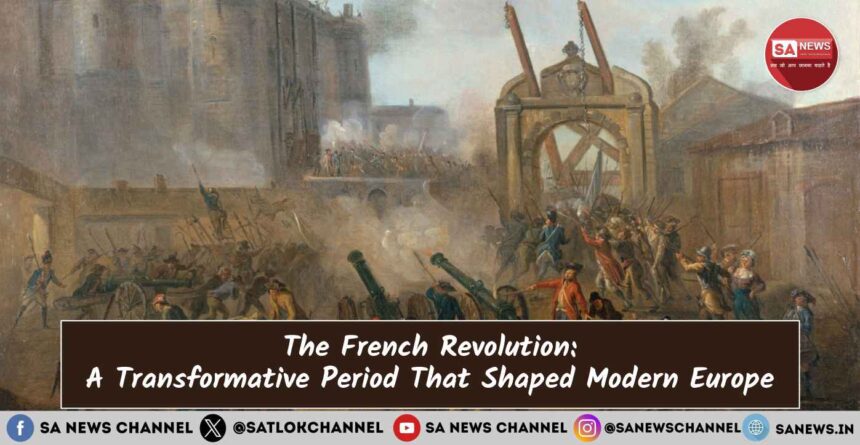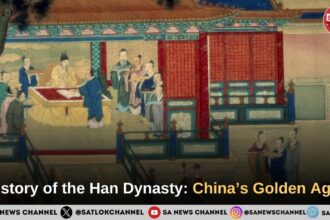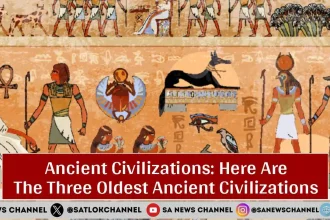The French Revolution. It was a name whispered with reverence and fear, conjuring images of guillotines, storming palaces, and a society teetering on the brink of chaos. But what often gets lost in the grand narrative of kings and queens, battles and decrees, are the “people” – the ordinary men and women whose lives were irrevocably transformed by this tumultuous period.
- Key Highlights on French Revolution
- France Before the Storm: A Society Ripe for Revolution
- A Nation on the Brink: The Gathering Storm
- The Estates-General: A Spark Ignites the Flame
- A Declaration of Defiance: The Tennis Court Oath
- The Storm Breaks: Bastille Day and the Fall of Royal Authority
- The Great Fear: Revolution Spreads Like Wildfire
- A New Dawn: The Declaration of the Rights of Man and Citizen
- From Monarchy to Republic: A Tumultuous Transition
- The Reign of Terror: A Descent into Darkness
- The Thermidorian Reaction and the Directory: Searching for Stability
- The Legacy of Revolution: Echoes Across the Centuries
- From Revolution to Revelation: True Freedom through Saint Rampal Ji Maharaj
- FAQs on The French Revolution
- 1.What were the main causes of the French Revolution?
- 2.What was the significance of the storming of the Bastille?
- 3.What was the Declaration of the Rights of Man and of the Citizen?
- 4.What was the Reign of Terror?
- 5.How did the French Revolution impact modern democracy?
- 6.What was the outcome of King Louis XVI’s attempt to flee?
- Connect With Us on the Following Social Media Platforms
This blog aims to breathe life into the dry historical accounts, to explore the French Revolution through the eyes of those who lived it. We’ll journey through the cobblestone streets of Paris, feel the rumble of discontent brewing in the hearts of the Third Estate, and witness firsthand the events that shook a nation to its core and reverberated across the world.
Key Highlights on French Revolution
- The French Revolution, spanning from 1789 to 1799, was a period of immense change.
- The revolution was fueled by a confluence of factors, including social inequality and economic turmoil.
- France’s rigid social hierarchy, the Estates System, deepened social divisions and fueled discontent among the common people.
- The nation’s financial crisis, aggravated by factors like extravagant spending and involvement in the American Revolution, added fuel to the fire.
- The storming of the Bastille on July 14, 1789, a symbol of royal authority, signaled the start of the revolution and the people’s challenge to the king’s power.
- The National Assembly abolished feudal privileges in August 1789, marking a decisive break from the old order, the “ancien régime”.
- The Declaration of the Rights of Man and of the Citizen, adopted in August 1789, enshrined principles of liberty, equality, and popular sovereignty.
- The French Revolution transitioned from a constitutional monarchy to a republic after the royal family’s failed attempt to flee in 1791.
- The Reign of Terror, from 1793 to 1794, was a brutal period of political repression marked by mass executions of perceived enemies of the revolution.
- The French Revolution had a lasting global impact, influencing the development of modern democracy, republicanism, nationalism, and human rights.
France Before the Storm: A Society Ripe for Revolution
To truly understand the French Revolution, we must first journey back to pre-revolutionary France, a society rigidly divided into three estates. Imagine a world where your birth determined your destiny, your rights, and even your chances of survival. This was the reality for the people of France under the “Estates system”.
- At the top sat the “First Estate”, comprised of the clergy – the men and women of the church who held immense power and influence. Exempt from taxes and living lives of relative luxury, they were often seen as detached from the daily struggles of the common people.
- Alongside them stood the “Second Estate”, the nobility. Born into privilege, they enjoyed vast wealth, land ownership, and exemption from the heavy taxes that burdened the rest of society. Their opulent lifestyles, often flaunted in the glittering halls of Versailles, stood in stark contrast to the poverty experienced by the majority of the population.
- And then there was the “Third Estate”, a catch-all term for the remaining 97% of the population. This diverse group encompassed everyone from wealthy merchants and lawyers to urban workers, rural peasants, and the poorest of the poor. They were the backbone of French society, yet they bore the brunt of the nation’s financial burdens, with little say in how they were governed.
Imagine the resentment simmering beneath the surface, the frustration building as the Third Estate witnessed the extravagance of the privileged few while they struggled to feed their families. This deep-seated inequality, this sense of injustice, would become the fertile ground in which the seeds of revolution would be sown.
A Nation on the Brink: The Gathering Storm
By the 1780s, France teetered on the edge of a precipice. Decades of lavish spending by the royal court, coupled with costly foreign entanglements like the American Revolution, had drained the nation’s coffers. Years of poor harvests, inefficient tax collection systems, and a mounting national debt had pushed the country to the brink of financial ruin.
Also Read: Thomas Edison: A Visionary Inventor Who Changed the World
King Louis XVI, well-meaning but indecisive, struggled to steer the nation through these turbulent waters. His attempts at financial reform were consistently met with resistance from the privileged First and Second Estates, who clung fiercely to their tax exemptions. Their refusal to share the burden of the nation’s financial woes would prove to be a fatal miscalculation, further inflaming the resentment of the Third Estate.
The Estates-General: A Spark Ignites the Flame
In a desperate bid to address the escalating crisis, Louis XVI made a fateful decision: he convened the “Estates-General”, a national assembly representing all three estates, for the first time in over 170 years. The year was 1789, and this seemingly insignificant act would set in motion a chain of events that would forever alter the course of French history.
Representatives from across the nation converged, each carrying the hopes and grievances of their respective estates. The Third Estate, emboldened by the ideas of Enlightenment thinkers and fueled by years of pent-up frustration, arrived with a radical demand: “equal representation and voting by head, not by estate”. They argued that since they represented the vast majority of the population, their voices should carry equal weight in the assembly.
The First and Second Estates, however, were unwilling to relinquish their traditional privileges. They clung to the old system, where each estate received a single vote, effectively giving them control over any decision-making process. The stage was set for a showdown, a clash between the old order and the rising tide of popular discontent.
A Declaration of Defiance: The Tennis Court Oath
Tension crackled in the air as the Estates-General convened. The Third Estate, their demands for equal representation rejected, realized they were facing a wall of resistance from the privileged classes. On June 17, 1789, in a moment of audacious defiance, they took a daring step – they declared themselves the “National Assembly”, claiming to represent the true will of the French people.
Three days later, finding themselves locked out of their meeting hall, they gathered in a nearby indoor tennis court. There, amidst the echoing emptiness, they swore a solemn oath: they would not disband until France had a “constitution”, a document that would guarantee the rights and freedoms of all citizens. This powerful act, known as the “Tennis Court Oath”, sent shockwaves through France. It was a direct challenge to the authority of the king and a declaration that the people would no longer be silenced.
The Storm Breaks: Bastille Day and the Fall of Royal Authority
On July 14, 1789, the simmering tensions finally boiled over. Fueled by rumors of royal troops massing in Paris and driven by a desperate fear that the revolution was about to be crushed, a crowd of Parisians descended upon the “Bastille”, a formidable fortress that had long served as a symbol of royal power and oppression.
The storming of the Bastille was a moment of raw, unbridled fury and jubilation. Ordinary men and women, armed with whatever weapons they could find, faced down the king’s soldiers, their cries for freedom echoing through the streets. The fall of the Bastille marked a turning point, a visceral demonstration that the people’s will could overcome even the most formidable symbols of royal authority.
This day, July 14th, would forever be etched in the annals of history as “Bastille Day”, the symbolic birth of the French Revolution.
The Great Fear: Revolution Spreads Like Wildfire
In the aftermath of the Bastille’s fall, a wave of panic known as the “Great Fear” swept through the French countryside. Fueled by rumors of marauding bandits and aristocratic reprisals, peasants rose up in spontaneous revolts, targeting the symbols of their oppression: manor houses, tax records, and the hated feudal system that had bound them for centuries.
On August 4th, 1789, the National Assembly, responding to the groundswell of popular unrest, took a momentous step. In a single night, they abolished feudal privileges, dismantling the ancient system that had divided French society for generations. This act, a pivotal moment in the revolution, signaled the end of the “ancien régime”, the old order, and the dawn of a new era.
A New Dawn: The Declaration of the Rights of Man and Citizen
On August 26, 1789, the National Assembly adopted one of the most important documents in human history: the “Declaration of the Rights of Man and of the Citizen”. This groundbreaking document proclaimed the fundamental rights and freedoms of all individuals, regardless of their social status or birth. It was a radical departure from the old order, where rights were granted by the king and varied depending on one’s place in society.
The Declaration asserted:
- The natural rights of man, including the right to liberty, property, security, and resistance to oppression.
- The principle of popular sovereignty, declaring that the power of government resides in the people.
- Freedom of speech and press, allowing for the open exchange of ideas and the free expression of dissent.
- Equality before the law, ensuring that all citizens would be treated fairly and impartially, regardless of their social standing.
These principles, revolutionary for their time, would have a profound impact on the course of history, inspiring movements for liberty and equality across the globe. They remain the cornerstone of modern democratic societies, a testament to the enduring power of the French Revolution’s ideals.
From Monarchy to Republic: A Tumultuous Transition
The initial phase of the revolution attempted to establish a “constitutional monarchy”, a system where the king’s power would be limited by a constitution and a representative assembly. Key reforms were implemented, including the administrative reorganization of France, the nationalization of church property, and the creation of a national guard.
However, suspicion and mistrust lingered between the monarchy and the revolutionaries. In June 1791, King Louis XVI and his family attempted to flee Paris in a desperate bid to escape the increasingly volatile political climate. Their capture at Varennes shattered what little trust remained in the monarchy, further strengthening republican sentiment.
The revolution took a decisive turn in August 1792 when a mob stormed the Tuileries Palace, the royal residence in Paris. The monarchy was suspended, and on September 22, 1792, the “First French Republic” was proclaimed. The trial and execution of Louis XVI in January 1793 marked a point of no return. France had crossed the Rubicon, and there was no turning back from the path of radical change.
The Reign of Terror: A Descent into Darkness
From 1793 to 1794, the revolution entered its most radical and controversial phase. The young republic, facing internal turmoil and war against foreign powers, was led by the “Committee of Public Safety”, a powerful group determined to safeguard the revolution from its enemies, both real and perceived. At the helm of this committee stood “Maximilien Robespierre”, a complex and enigmatic figure who would become synonymous with the most brutal period of the revolution.
The “Reign of Terror”, as this period came to be known, saw mass executions of those deemed “enemies of the revolution.” The guillotine, a chilling symbol of revolutionary justice, claimed the lives of thousands, from aristocrats and priests to ordinary citizens suspected of disloyalty. Radical social and economic policies were implemented, including price controls, the redistribution of land, and a new calendar that sought to break with the traditions of the past.
The Terror was a period of intense paranoia and fear, where accusations flew freely, and even a whisper of dissent could lead to imprisonment or death. It was a time of both idealism and brutality, a desperate attempt to forge a new society amidst the chaos of revolution and war.
The Thermidorian Reaction and the Directory: Searching for Stability
The Reign of Terror reached its climax in July 1794 when Robespierre himself fell victim to the revolution he had helped to unleash. His execution, known as the “Thermidorian Reaction”, marked the beginning of a period of relative calm and a shift away from the radical policies of the Terror.
The “Directory”, a five-man executive body, took control of France, attempting to find a middle ground between the extremes of the revolution. However, the Directory was plagued by political instability, financial problems, and ongoing military challenges. Corruption and infighting weakened its authority, leaving France vulnerable to the ambitions of a young general named Napoleon Bonaparte.
The Legacy of Revolution: Echoes Across the Centuries
The French Revolution, though a relatively short period in the grand sweep of history, left an indelible mark on the world. It shattered the foundations of absolute monarchy, ignited the flames of modern nationalism, and gave birth to the enduring ideals of liberty, equality, and fraternity. Its impact extended far beyond the borders of France, inspiring revolutions and reform movements across the globe.
Here are just a few of the French Revolution’s lasting legacies:
- The Rise of Democracy and Republicanism: The revolution challenged the very notion of divine right monarchy, asserting the principle of popular sovereignty and paving the way for the rise of democratic republics around the world.
- The Birth of Modern Nationalism: The revolution fostered a sense of shared identity and national pride among the French people, contributing to the development of modern nationalism, a force that would shape the political landscape of Europe and the world in the centuries to come.
- The Separation of Church and State: The revolution’s attack on the privileges of the church and the nationalization of church property laid the groundwork for the separation of church and state, a key principle of modern secular societies.
- The Expansion of Civil Rights: The Declaration of the Rights of Man and Citizen, with its emphasis on individual freedoms and legal equality, became a touchstone for future struggles for civil rights, inspiring movements for abolition, suffrage, and social justice.
The French Revolution was a complex and multifaceted event, a crucible of idealism, violence, and radical change. It was a period of both great hope and terrible suffering, a testament to the human capacity for both progress and destruction. Its legacy continues to shape our world today, reminding us of the power of ideas, the dangers of unchecked power, and the enduring quest for liberty and equality for all.
From Revolution to Revelation: True Freedom through Saint Rampal Ji Maharaj
The French Revolution was a fight for liberty, equality, and fraternity, challenging oppression in the material world. However, Saint Rampal Ji Maharaj teaches that true freedom goes beyond political or social change; it lies in spiritual transformation. Just as the French sought to break free from tyranny, Saint Rampal Ji Maharaj emphasizes breaking free from the spiritual ignorance and false practices that have held humanity captive for centuries.
According to His teachings, the real revolution must occur within each individual—an awakening to the eternal truth revealed by the Supreme God, Kabir. Saint Rampal Ji explains that worldly justice and fairness are incomplete without spiritual enlightenment. Only by understanding the true nature of God and engaging in His sincere worship can we escape the cycle of birth, death, and suffering.
True equality, unity, and peace can only be achieved when people will reach eternal abode Satlok, where no evil exists. The revolution of the soul is far more impactful than any political movement because it leads to eternal salvation. By following the path of devotion to God Kabir, humanity can experience genuine liberation, justice, and spiritual fulfillment.
FAQs on The French Revolution
1.What were the main causes of the French Revolution?
The revolution was caused by social inequality, economic hardship, and political discontent, driven by the rigid “Estates System” and the monarchy’s financial crises.
2.What was the significance of the storming of the Bastille?
The storming of the Bastille on July 14, 1789, marked the people’s rebellion against royal tyranny and is celebrated as the birth of the French Revolution.
3.What was the Declaration of the Rights of Man and of the Citizen?
Adopted in August 1789, this document proclaimed fundamental rights such as liberty, equality, and popular sovereignty, shaping modern democratic ideals.
4.What was the Reign of Terror?
The Reign of Terror (1793-1794) was a period of political repression where thousands were executed for perceived disloyalty, driven by fear and radical leadership.
5.How did the French Revolution impact modern democracy?
The revolution challenged absolute monarchy and introduced the idea of popular sovereignty, influencing democratic movements worldwide.
6.What was the outcome of King Louis XVI’s attempt to flee?
King Louis XVI’s failed escape in June 1791 led to a loss of trust in the monarchy, strengthening republican sentiment and eventually resulting in his execution.









